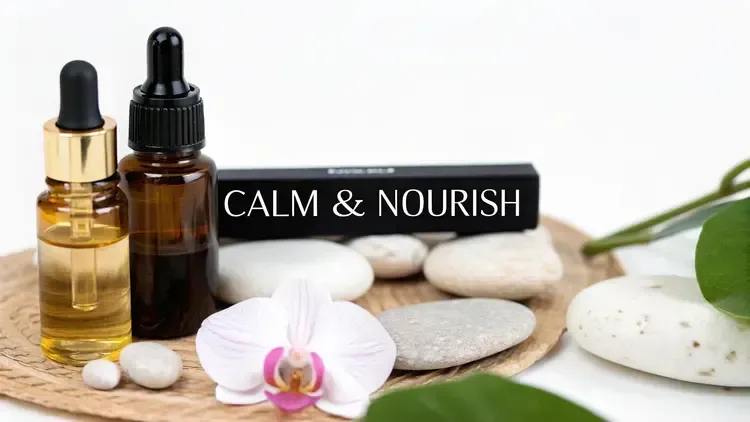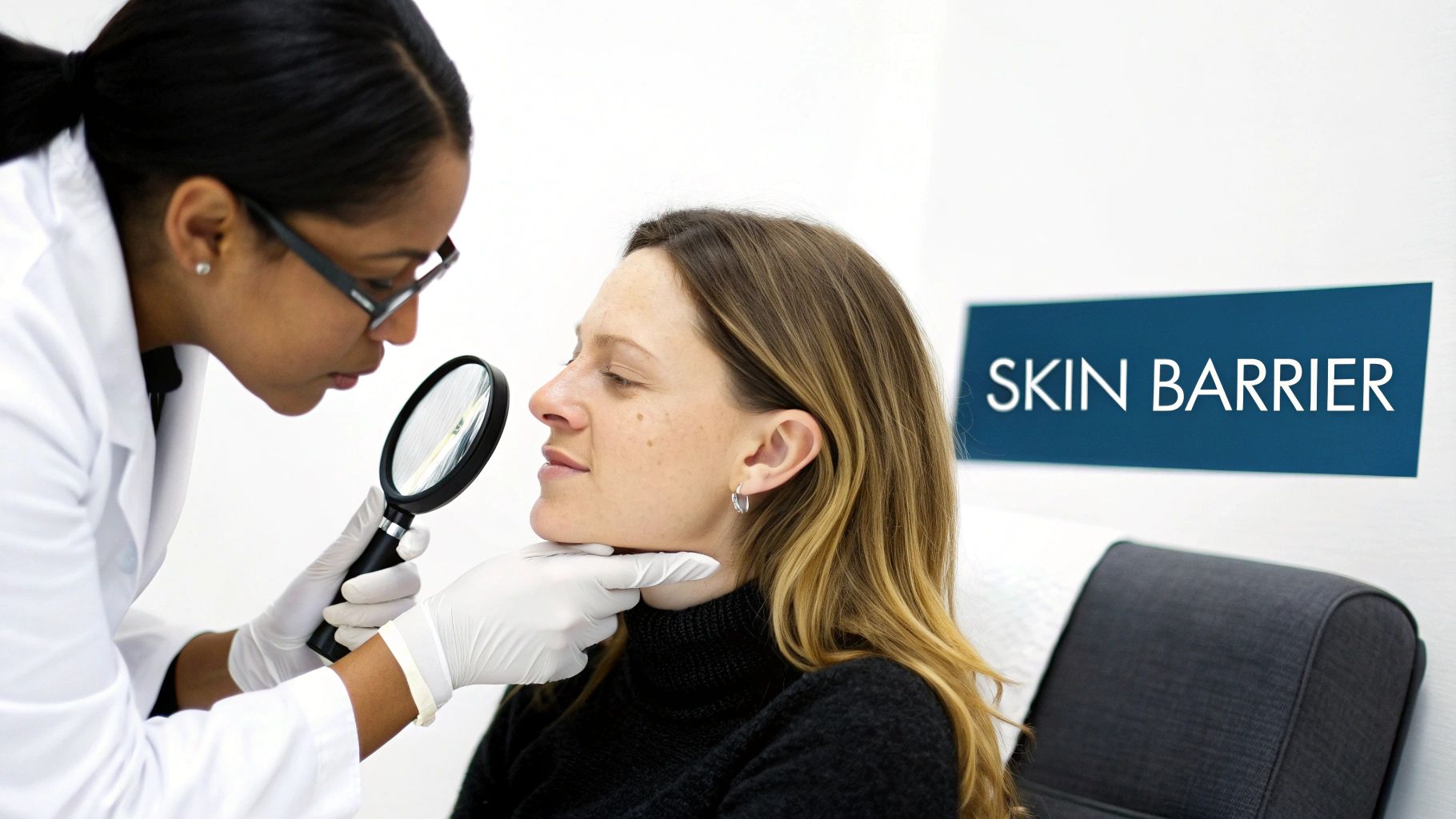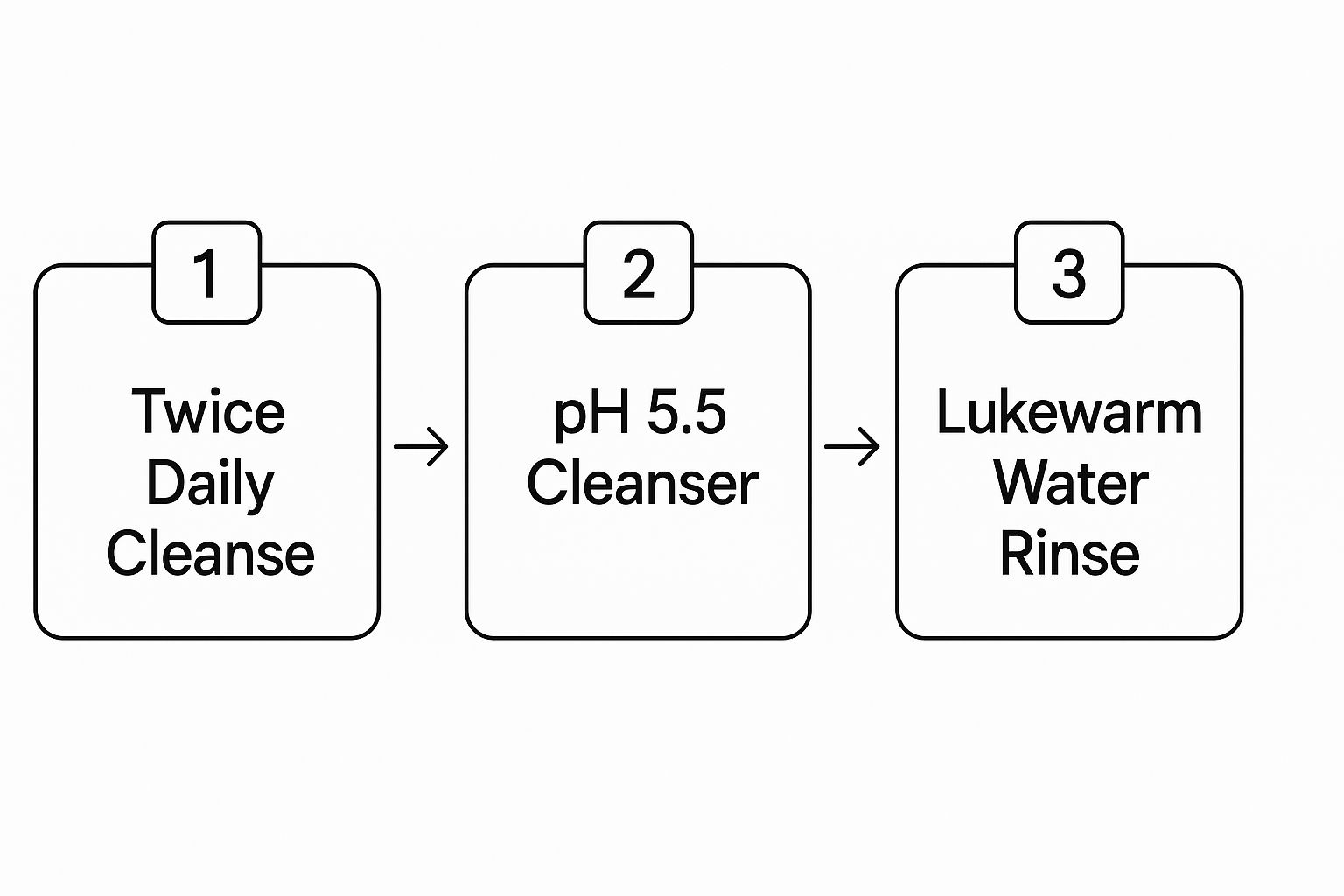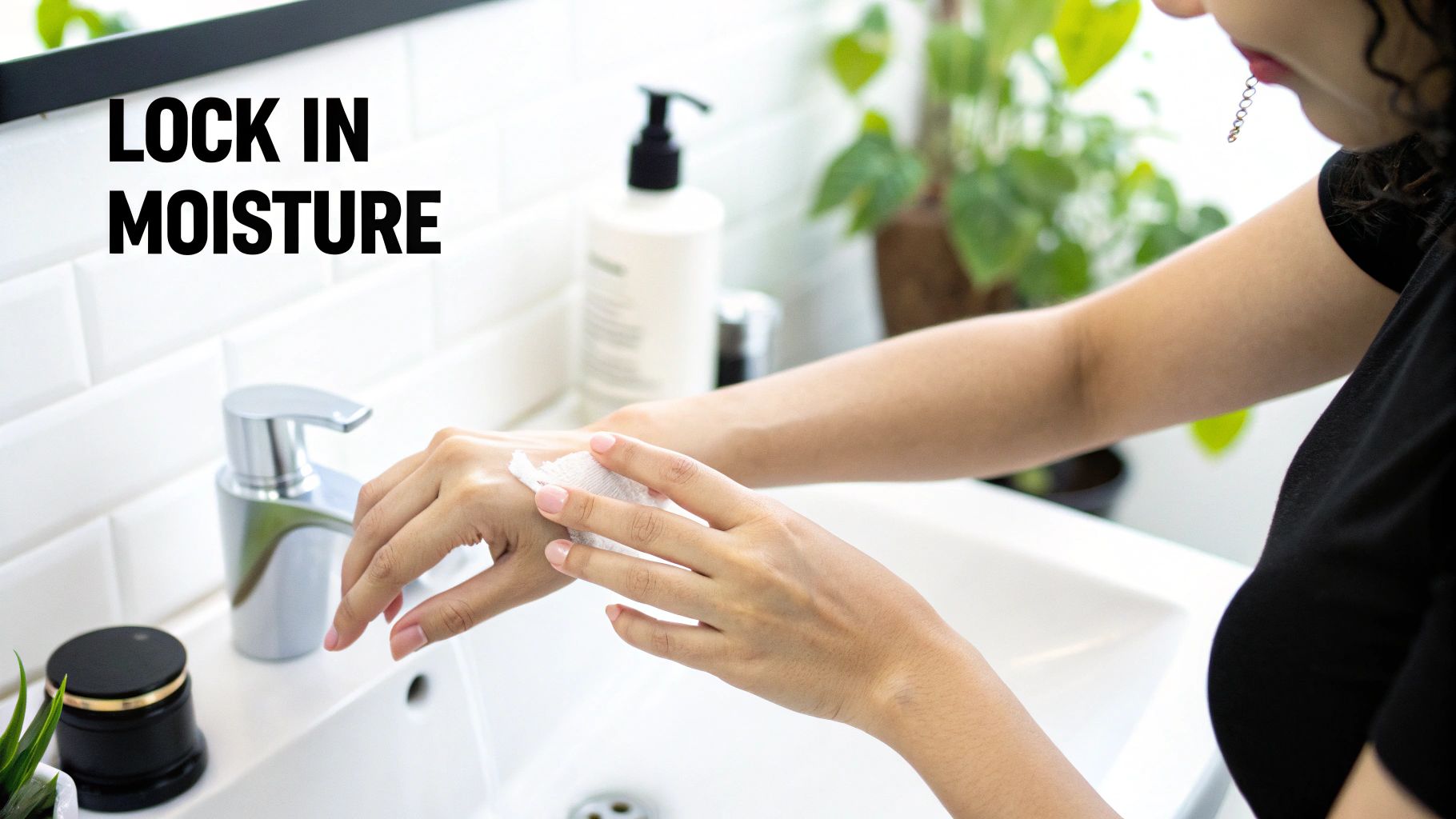
How to Repair Skin Barrier: Expert Tips & Best Practices
To start repairing your skin barrier, the first thing to do is strip your routine back to the essentials. Think gentle, non-stripping cleansers and moisturizers packed with ceramides, cholesterol, and fatty acids. This "back to basics" approach is all about removing potential irritants and giving your skin the exact building blocks it needs to heal itself and restore its protective function.
What Is the Skin Barrier and Why Does It Matter?

Before we can really dive into how to fix it, let's get a clear picture of what the skin barrier is and why it’s so critical. The simplest way to think about it is as your skin’s personal security guard.
Its official name is the stratum corneum, and it’s the very outermost layer of your skin. The classic "brick-and-mortar" analogy is genuinely the best way to visualize it. The "bricks" are your skin cells (called corneocytes), and the "mortar" holding them together is a mix of natural fats like ceramides, cholesterol, and fatty acids.
This structure has two main jobs: keeping good stuff like water in, and keeping bad stuff like pollutants, allergens, and bacteria out. When your barrier is working properly, your skin looks and feels calm, hydrated, and strong. It's only when things go wrong that you really notice it.
How to Tell If Your Skin Barrier Is Damaged
So, what happens when that "mortar" starts to crumble? You get tiny, invisible cracks that leave your skin exposed and vulnerable. A compromised barrier can’t do its job, which often leads to a whole host of frustrating issues.
Learning to spot the signs is the first step to getting your skin back on track. A little self-diagnosis can go a long way.
To help you figure out what’s going on with your skin, here's a quick comparison of the signs you'll see with a damaged barrier versus what healthy skin looks and feels like.
Signs of a Damaged Skin Barrier vs Healthy Skin
Symptom Damaged Barrier Healthy Barrier Feel & Texture Feels tight, rough, or flaky. Can be itchy or sting. Feels smooth, soft, and comfortable. Appearance Looks red, blotchy, or generally irritated. Appears even-toned, calm, and plump. Hydration Level Appears dull and dehydrated, even with moisturizer. Looks hydrated, supple, and has a natural glow. Reactivity Reacts to products that used to be fine. Is resilient and tolerates products well.
Seeing your skin’s symptoms in the "Damaged Barrier" column is a clear signal that it's time to focus on repair. A healthy barrier is the foundation for everything else, so addressing these issues first is key.
A healthy skin barrier is the foundation of all skin health. Almost every common concern, from acne to premature aging, can be traced back to a compromised barrier that isn't functioning optimally.
The Big Shift Toward Barrier Repair
Thankfully, the importance of a strong skin barrier isn't some niche secret anymore—it's become a major focus in skincare. You see it everywhere now, with brands formulating products specifically to support and strengthen this vital layer.
This isn't just a fleeting trend. The global market for skin barrier-specific products was valued at around US$ 373.4 million and is expected to climb to nearly US$ 540.9 million by 2034. You can explore the complete market analysis on Fact.MR to see the data for yourself.
This growth shows a huge shift in how we think about skincare. We’re moving away from harsh, stripping treatments and toward nurturing our skin’s natural defenses. By focusing on repair and maintenance, you're not just fixing a temporary problem—you're setting your skin up for long-term health and resilience.
Building a Gentle Skincare Foundation
When your skin barrier is on the fritz, your first and most important move is a strategic retreat. Think of it as putting your skin on a recovery diet. This means hitting pause on all the "extras"—the aggressive exfoliants, high-strength actives, and sudsy cleansers that are likely part of the problem. Your immediate goal is to stop the cycle of irritation and give your skin the calm, quiet space it needs to start healing itself.
This isn't about piling on more products. It's about getting back to basics with the right products and, more importantly, getting rid of the wrong ones. A damaged barrier is essentially an open wound. You have to handle it with care, not blast it with powerful ingredients, even the ones that are normally good for your skin.
Strip Back to the Essentials
First things first: do a "skincare audit." Go through your current lineup and temporarily sideline anything that could be considered harsh or potentially irritating.
This means putting away:
Harsh Cleansers: If your cleanser leaves your skin feeling tight or "squeaky clean," it's almost certainly stripping away your natural oils. Foaming cleansers with sulfates are notorious for this.
Physical Scrubs: Things like walnut shells, sugar scrubs, or abrasive brushes are far too rough for compromised skin. They can create micro-tears and make everything worse.
High-Strength Actives: This is a big one. For now, you need to shelve your potent retinoids, strong vitamin C serums (especially those with L-ascorbic acid), and exfoliating acids like glycolic, lactic (AHAs), or salicylic acid (BHA).
Remember, this is temporary. Once your skin has fully recovered, you can slowly bring these powerhouses back. For example, while a professional chemical peel can deliver incredible results on healthy skin, using one on a damaged barrier would be a disaster. You can check out some impressive chemical peel before and after transformations to see what’s possible once your skin is strong and resilient again.
Master the Gentle Cleanse
With the troublemakers out of the picture, your cleansing routine becomes the absolute cornerstone of your recovery. This is non-negotiable. It sets the stage for every single product you apply afterward, so the focus has to be on cleaning effectively without causing more disruption.

Following this simple sequence twice a day helps lift away impurities without stripping away the essential lipids your skin is desperately trying to rebuild.
The perfect cleanser for barrier repair is a pH-balanced, non-foaming, creamy, or milky formula. Healthy skin has a naturally acidic pH of around 4.5-5.5, and using a cleanser in this same range helps keep that delicate balance. Soaps and alkaline cleansers can throw your skin's pH out of whack, which only weakens the barrier further and creates a welcome mat for bad bacteria.
Pro-Tip: When you wash your face, use only your fingertips and gentle, circular motions. No washcloths or cleansing brushes for now. Afterward, pat your skin dry with a soft towel—never, ever rub.
The Importance of Water Temperature and Damp Skin
One of the easiest yet most impactful changes you can make is turning down the heat. Hot water might feel comforting, but it's a sworn enemy of your skin barrier. It strips away those natural oils (the "mortar" holding your skin cells together) and can dial up inflammation and redness.
Always, always use lukewarm water. It’s just warm enough to do the job without the downsides of temperature extremes.
Here’s another little trick that makes a huge difference: after cleansing and gently patting your face, don't let it dry completely. Applying your next product, like a hydrating toner or serum, to slightly damp skin is a game-changer. Damp skin is more permeable, so it soaks up hydrating ingredients much more efficiently and helps lock in that moisture right from the start. This simple habit really amplifies the benefits of everything you apply next.
Choosing Ingredients That Actively Rebuild

Once you’ve calmed things down with a simple, gentle routine, it’s time to switch from defense to offense. Repairing a skin barrier isn't just about what you avoid; it's about actively giving your skin the exact materials it needs to rebuild itself. Think of it like bringing in a specialized construction crew armed with the precise bricks and mortar your skin has lost.
This is where you need to get strategic. Instead of just grabbing any thick cream off the shelf, you’ll want to become a bit of an expert at reading ingredient lists. The goal is to find formulas loaded with components that are known to restore and fortify your skin's natural defenses from the inside out.
The Foundational Lipid Trio
Your skin’s barrier is literally held together by a specific mix of lipids—the fats that fill the gaps between your skin cells. The big three are ceramides, cholesterol, and fatty acids. When your barrier is struggling, it’s because this "mortar" has been depleted. To fix it properly, you need to put all three back.
Ceramides: These are the undisputed stars of barrier repair, making up about 50% of your skin's lipid structure. As waxy lipids, they are absolutely essential for preventing water loss and shielding your skin from environmental junk.
Cholesterol: Don't get this confused with the cholesterol in your diet. In skincare, it’s a crucial stabilizer. It helps keep the barrier fluid and flexible, stopping it from getting rigid and cracked.
Fatty Acids: These help maintain the skin's overall structure and integrity. You'll often see ingredients like linoleic and linolenic acid, which are vital for healthy barrier function.
Products that are formulated with this trio in the right ratio are powerhouse healers. Look for moisturizers that specifically call out these ingredients to give your skin the complete support it’s craving.
The All-Star Supporting Cast
Beyond those core lipids, a few other ingredients are incredibly helpful in the healing process. This supporting cast works to soothe inflammation, supercharge your skin’s own regenerative powers, and deliver deep, lasting hydration.
An effective barrier repair strategy goes beyond simple hydration. It involves a multi-pronged approach that calms existing irritation while providing the essential building blocks for reconstruction, ensuring a stronger, more resilient barrier for the future.
One of the most valuable players here is niacinamide, also known as Vitamin B3. It’s a true multitasker. Niacinamide has been shown to encourage your skin to produce its own ceramides, which is like teaching it to repair itself. Plus, its anti-inflammatory properties are fantastic for calming the redness and general crankiness that come with a compromised barrier.
Soothing Agents for Immediate Relief
When your skin feels raw and reactive, you need ingredients that bring immediate comfort while also supporting long-term repair. Two standouts here are panthenol and centella asiatica.
Panthenol (Pro-Vitamin B5): This is a powerful humectant, which means it pulls moisture into the skin and locks it in. It also has incredible anti-inflammatory and wound-healing properties, making it perfect for soothing angry, irritated skin.
Centella Asiatica (Cica): You might have heard this called "tiger grass." Cica is a medicinal herb famous for its calming and reparative abilities. It’s a go-to for reducing redness, soothing sensitivity, and speeding up the healing process.
Finding products that feature these soothers can make the repair journey a whole lot more comfortable. They work beautifully alongside the rebuilding lipids to bring your skin back to a happy, calm state.
The demand for these types of targeted treatments is clear. The global skin repair market was valued at around USD 84.96 billion and is expected to surge to about USD 160.01 billion by 2034. This trend shows a major consumer shift toward prioritizing skin health.
Bringing these targeted ingredients into your routine is a huge step up from basic moisturizing. While a gentle routine lays the foundation, this is where the active reconstruction really begins. Down the line, professional treatments can also accelerate this process. For example, once your barrier is stable, therapies like microneedling can significantly boost collagen and aid in long-term structural repair. You can explore some amazing microneedling before and after results to see just how powerful it can be for strengthening skin. Choosing the right ingredients now paves the way for a stronger, healthier, and more resilient complexion.
You did it. You got your skin barrier back on track, and that’s a huge win. But here's the thing I always tell my clients: the real work begins now. Protecting that newly repaired barrier isn't a one-and-done deal; it's about shifting your mindset to long-term maintenance.
Your number one priority? Sunscreen. Every. Single. Day. I can't stress this enough. UV radiation is a primary offender when it comes to wrecking a healthy barrier. It quietly chips away at your skin’s defenses, even on cloudy days or when you're just sitting by a window. That constant exposure fires up inflammation and degrades the essential lipids you just worked so hard to replenish, potentially undoing all your progress.
Make Sunscreen a Daily Ritual
To truly protect your skin, you need to commit to a broad-spectrum SPF 30 or higher every morning. Think of it as fundamentally part of getting dressed. Broad-spectrum is key because it shields you from both UVA rays (the aging rays) and UVB rays (the burning rays), both of which are bad news for your barrier.
One of the biggest questions I get from people with sensitive, recovering skin is which sunscreen to choose. It really comes down to two types, so let’s lay it out.
Sunscreen Type Key Ingredients How It Works Best For Mineral (Physical) Zinc Oxide, Titanium Dioxide Forms a physical shield on the skin's surface to reflect UV rays away. Sensitive, reactive, or acne-prone skin. It’s the gentler option and far less likely to cause a reaction. Chemical Avobenzone, Oxybenzone, Octinoxate Absorbs into the skin and converts UV radiation into heat, which is then released. Active lifestyles. These formulas are often water-resistant and tend to rub in clear.
Honestly, if your skin is still in that delicate healing phase, mineral sunscreens are almost always the safer bet. I often recommend formulas with zinc oxide because it does double duty—it not only protects but also has incredible anti-inflammatory properties that can help keep your skin calm.
"Sunscreen is the ultimate product for defending your skin from one of the worst sources of environmental damage—the sun. The UVA and UVB rays that are given off by the sun will only contribute to a damaged moisture barrier. That’s why it’s so important to apply sunscreen generously and consistently, rain or shine."
Bolster Your Defenses with Antioxidants
Once your barrier feels strong and isn't reacting to every little thing, it’s a good time to bring in some extra support: antioxidants. I like to think of them as sunscreen's best friend. SPF is your first line of defense, but antioxidants work behind the scenes to neutralize the environmental damage that sneaks past, like free radicals from pollution.
When you're ready, here are some great antioxidant ingredients to look for:
Vitamin C: Don't jump back to a high-potency L-Ascorbic Acid right away. Start with a gentle, stable form like Sodium Ascorbyl Phosphate. It's great for brightening and provides solid antioxidant protection without the irritation.
Niacinamide: This is a fantastic maintenance ingredient. It continues to strengthen the barrier while also lending its antioxidant power.
Vitamin E (Tocopherol): You’ll often find this paired with Vitamin C. It’s a wonderful moisturizer on its own and helps keep the Vitamin C stable and effective.
Green Tea Polyphenols: These are powerhouses for calming inflammation and fighting off environmental aggressors. A perfect choice for skin that's prone to redness.
The golden rule here is to go slow. When you reintroduce any active ingredient, even a seemingly gentle antioxidant serum, start with just a couple of applications a week. Watch how your skin responds. Keeping your barrier healthy is a daily commitment, but with diligent sun protection and smart antioxidant use, you're setting your skin up for long-term strength and resilience.
Lifestyle Changes That Support Skin Health

While your skincare routine is critical for barrier repair, what you do outside the bathroom often matters just as much. I’ve seen it time and time again: a client’s skin just won’t improve until we look at the bigger picture. True, lasting skin health is about connecting your daily habits to what you see in the mirror.
Think of it this way: your skin is often a reflection of your internal health. We talk a lot about the gut-skin axis in aesthetics, and for good reason. Inflammation that starts in your gut can absolutely show up on your face as redness, sensitivity, and breakouts. So, supporting your gut isn't just a wellness trend; it's a fundamental step toward stronger skin.
Fueling Your Skin From Within
Your diet literally provides the building blocks for your skin barrier. If you're not giving your body the right materials, it can't build a strong defense. Focusing on anti-inflammatory, nutrient-rich foods can completely change your skin's ability to heal itself.
A great place to start is with essential fatty acids. These are non-negotiable for a healthy lipid matrix. Try to incorporate:
Omega-3s from sources like salmon, mackerel, chia seeds, and walnuts.
Healthy Fats you can find in avocados, almonds, and good quality olive oil.
And please, don't forget to hydrate! Drinking enough water keeps your skin cells plump and functioning properly from the inside. When you're dehydrated, your barrier quickly becomes dull, tight, and compromised.
I always tell my clients you can't moisturize your way out of a poor diet or chronic stress. A holistic approach that nurtures your body inside and out is the only way to achieve truly resilient skin.
The Impact of Stress and Sleep
Chronic stress is a notorious barrier-wrecker. When you're constantly stressed, your body pumps out cortisol, a hormone that fuels inflammation and breaks down the very lipids and proteins holding your barrier together. Find what works for you to de-stress—maybe it's meditation, yoga, or just a daily walk. This isn't fluff; it's a powerful skincare tool.
Sleep is just as crucial. It’s when your skin’s repair crew goes to work. Aiming for 7-9 hours of quality sleep gives your body the downtime it needs to regenerate cells, calm inflammation, and rebuild what was damaged during the day.
When to Seek Professional Support
Sometimes, you can do everything right at home, and your skin still needs a helping hand. If your barrier isn't bouncing back, or you're struggling with ongoing issues like rosacea or extreme sensitivity, it might be time to see a professional.
An aesthetician or dermatologist can offer treatments that go deeper than what you can do at home:
LED Light Therapy: We use specific wavelengths, usually red light, to significantly calm inflammation and kickstart cellular repair, speeding up the whole healing process.
Specialized Facials: A pro can use gentle, clinical-grade ingredients to perform a hydrating facial that soothes irritation and floods the skin with barrier-loving nutrients.
Medical-Grade Solutions: In more severe cases, professionals might use advanced skin barrier repair dressings. These create the perfect healing environment and are a big deal in clinical care. In fact, this market was valued at USD 1.2 billion and is expected to hit USD 2.5 billion by 2033.
Getting professional help can also set you up for success later. Once your barrier is strong and healthy, you can start addressing other concerns. For instance, a strong barrier is the first and most important step before you can effectively treat scarring. You can read our guide on microneedling for acne scars to see just how foundational a healthy barrier is.
Your Top Skin Barrier Repair Questions, Answered
Once you've stripped back your routine and committed to a gentle, healing approach, a new set of questions almost always pops up. I hear them from clients all the time. You're doing everything right, but you're wondering, "How long will this actually take?" or "When can I use my favorite vitamin C serum again?"
Getting the hang of this recovery phase is all about managing expectations and being smart about your next steps. Let's walk through the most common questions I get asked, so you can navigate your healing journey with confidence.
How Long Does It Realistically Take To Heal?
This is the big one, and the honest, expert answer is: it really depends. There's no magic number here. The timeline for repairing your skin barrier hinges entirely on how much stress it's been under.
For Minor Irritation: Let's say you got a little too excited with a new exfoliating acid for a week. The good news is your skin is incredibly resilient. If you get back to a simple, soothing routine right away, you can expect to feel a real difference in just 1-2 weeks. That tell-tale redness and tightness will start to calm down pretty quickly.
For Moderate Damage: This is the boat most people find themselves in. Maybe you've been using a harsh, stripping cleanser for months, skipping moisturizer, and being a bit too aggressive with your active ingredients. For this kind of cumulative damage, you'll need to be more patient. Give it a solid 2-4 weeks for your barrier to truly start feeling strong and comfortable again.
For Chronic or Severe Damage: If your barrier has been struggling for years—maybe from consistent over-exfoliation, an untreated skin condition like rosacea, or significant sun damage—this is a marathon, not a sprint. Rebuilding can take 6 weeks or even longer. Patience is everything here.
A damaged moisture barrier is not a permanent condition. The skin is always working to repair itself. If you remove the source of the damage and provide the right support, you should see noticeable improvement within a few weeks.
The most important thing you can do is be consistent. Stick to that simple, nourishing routine without trying to add anything new. Your skin needs that calm, stable environment to do its best healing work.
When Can I Reintroduce My Actives?
I get it. After weeks of being gentle, the temptation to dive back into your favorite high-strength serums is strong. But reintroducing active ingredients like retinoids and exfoliating acids has to be done carefully to avoid sending your skin right back to where you started.
My golden rule is to wait until your skin feels completely normal again. What does that mean? No more redness, no stinging when you apply products, no persistent tightness, and no flaky patches. Your skin should feel comfortable and hydrated on its own before you even think about it.
Once you’re there, follow this reintroduction plan:
Choose One Active: Don't try to bring back both your retinol and your glycolic acid at the same time. Pick just one to start with.
Start Low and Slow: For the first couple of weeks, use that active just once or twice a week. A great pro tip is to apply it over your moisturizer (a technique called "buffering") to reduce its initial kick.
Monitor Your Skin Closely: Pay attention to how your skin looks and feels the next day. See any pinkness or feel any irritation? That's your cue to take a few extra days off before trying again. If your skin is handling it well after a few weeks, you can slowly work your way back up in frequency.
The Most Common Repair Mistakes to Avoid
Even with the best intentions, it’s so easy to make a wrong turn that sets your progress back. I see these same slip-ups happen all the time in my practice. Knowing what they are can help you stay on track.
The biggest mistake by far is impatience. People expect overnight miracles and get frustrated when their skin isn't perfect in seven days. They either give up on the gentle routine or, even worse, try to "speed things up" with a harsh scrub or mask, which just creates a major setback.
Another common error is using a moisturizer that isn't truly reparative. A simple, heavy cream often isn't enough. Your moisturizer must contain those key barrier-rebuilding ingredients we talked about—ceramides, cholesterol, and fatty acids. These are the materials your skin actually uses to reconstruct itself, not just feel temporarily coated.
Finally, skipping sunscreen will undo all your hard work. Just one day of unprotected sun exposure can trigger a new wave of inflammation, destroying the fragile new lipids you've worked so hard to build. Sunscreen isn't optional; it's a non-negotiable part of your daily barrier maintenance plan.
At Olive Skin Therapy, we believe that true skin health starts with a strong, resilient barrier. If you're struggling to get your skin back on track or want expert guidance on building a routine that works for you, we're here to help. Olivia Codd specializes in customized treatments that calm, heal, and strengthen your skin from the inside out.
Ready for personalized, professional care? Book your appointment at Olive Skin Therapy today and start your journey toward a calm, healthy complexion.
